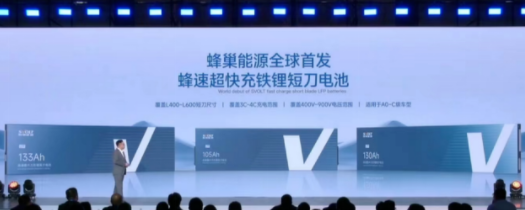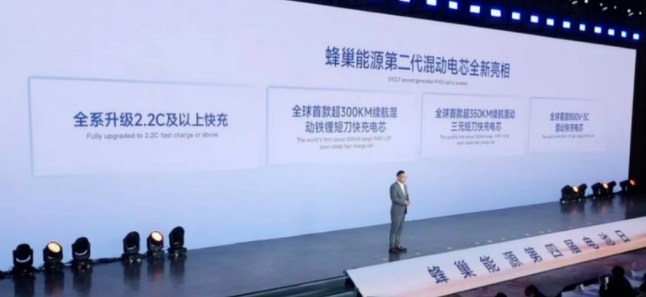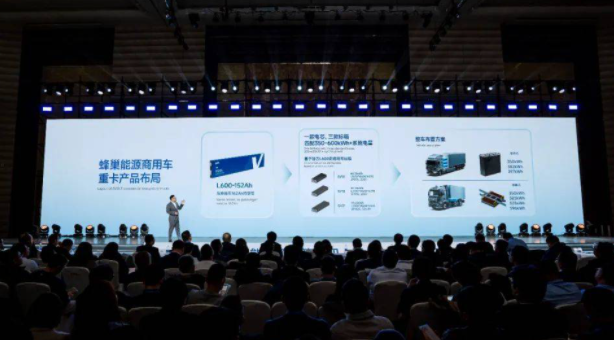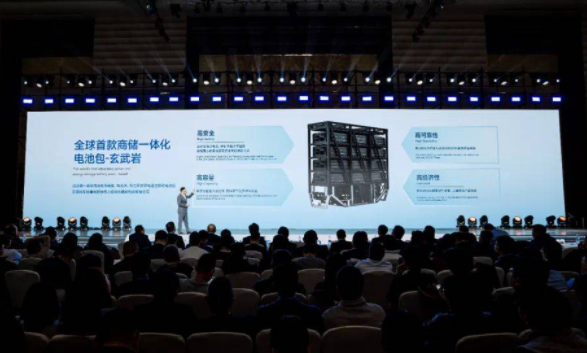On December 12, the 4th Svolt Battery Day arrived as scheduled.
Svolt has comprehensively upgraded its dagger battery; supports fast charging capabilities above 2C; is trying to use an 800V architecture in PHEV models; and achieves product scale effects by sharing batteries for passenger cars and commercial storage to reduce costs.
BEV: short blade + fast charge
Svolt Chairman & CEO Yang Hongxin believes that 2024 will be the first year of the 800V system. In his view, consumer psychology has undergone some changes. In the past, the biggest concern when buying new energy vehicles was range anxiety, but it has evolved into charging anxiety and energy replenishment anxiety.
Consumers need faster energy replenishment.
Yang Hongxin predicts that the proportion of 800V in BEVs will likely reach 37% by 2028.
From a process perspective, Yang Hongxin believes that 800V will first be used in B-class and above cars, and then gradually spread downwards to A-class cars.
In response to this demand, Svolt has fully upgraded the BEV blade battery with fast charging. All products launched by Svolt next year will fully popularize 2.2C, mass-produce 3C and 4C batteries, and pre-research 5C batteries.
Specifically, the charging speed of L400 and L600 is increased to the 3C-4C range, the voltage covers 400 to 900V, and A0 to C-class models are covered.
In terms of products, there are mainly three types of batteries, two L600 batteries for the 400V platform, and one L400 battery core for the 800V platform.

For example, the L600's fast-charging lifepo4 battery is available in 133Ah and 130Ah models. The 133Ah lifepo4 battery cell can achieve 15 minutes of fast charging and 600 kilometers of battery life; the smaller capacity 130Ah can achieve 4C and 600 kilometers of battery life.
Yang Hongxin also said that Svolt will launch the second product Dragon Scale Battery next year, which will achieve 4C fast charging under the 800V platform.
The above-mentioned fast-charging batteries are all based on the lithium iron phosphate system.
When it comes to 6C fast charging in the future, Yang Hongxin said that they will use a ternary system to achieve it.
In Yang Hongxin's view, short-blade batteries are more suitable for fast charging. In terms of length, compared to long blades, 400/600 mm short blade batteries have higher finished product efficiency; the shape of the blade makes it more efficient than ordinary batteries. If it is 25% thinner, its expansion force and interface circulation will be better. Cooling is simpler, whether it is 5C or 6C, it can be achieved with only upper and lower water-cooling plates. The way the poles come out on both sides is more suitable for C2C design. The water-cooling plate can be placed on top and used as a lower floor. At the same time, it sprays at the bottom or both sides, which is less harmful to the cab and has stronger compatibility.
For example, the L600's fast-charging lifepo4 battery is available in 133Ah and 130Ah models. The 133Ah battery cell can achieve 15 minutes of fast charging and 600 kilometers of battery life; the smaller capacity 130Ah can achieve 4C and 600 kilometers of battery life.
Yang Hongxin also said that Svolt will launch the second product Dragon Scale Battery next year, which will achieve 4C fast charging under the 800V platform.
The above-mentioned fast-charging batteries are all based on the lithium iron phosphate system.
When it comes to 6C fast charging in the future, Yang Hongxin said that they will use a ternary system to achieve it.
In Yang Hongxin's view, short-blade batteries are more suitable for fast charging. In terms of length, compared to long blades, 400/600 mm short blade batteries have higher finished product efficiency; the shape of the blade makes it more efficient than ordinary batteries. If it is 25% thinner, its expansion force and interface circulation will be better. Cooling is simpler, whether it is 5C or 6C, it can be achieved with only upper and lower water-cooling plates. The way the poles come out on both sides is more suitable for C2C design. The water-cooling plate can be placed on top and used as a lower floor. At the same time, it sprays at the bottom or both sides, which is less harmful to the cab and has stronger compatibility.
Of course, to achieve fast charging, in addition to product form, Honeycomb Energy is also improving battery cell materials and processes. For the positive electrode, they use advanced doping coating technology to reduce the ion transmission path by 40% and reduce the resistance by 10%; for the negative electrode, they use new surface technology, primary particle and secondary particle matching technology, and liquid absorbency. Better additives to achieve better negative electrode power performance.
At the process level, the short knife is inherently similar to the direct welding process of all poles, and the current carrying area is larger.
In terms of products, Yang Hongxin said that in April next year, about four models will put 2.2C iron lithium on the market. In the third quarter, a model of Nezha will be launched on the market. There are also some leading automobile companies in China, and two brand-new platform models are on the market, at the end of the year, there will be an even more important one, the L400's 4C super-charged battery.
In other words, in 2024, all the above products will be launched to the market through vehicle installation.
PHEV: fast charging + ultra-long range + 800V
Svolt is also betting heavily on PHEV models. According to Yang Hongxin, the fast charging capability of PHEV models is also very necessary. Due to slow charging and long time occupying charging piles, PHEV owners are often discriminated against by BEV owners, especially during holidays.
In response to this pain point, Svolt has pushed the charging rate of PHEV iron-lithium to above 2.2C, while achieving full battery life.

Yang Hongxin believes that currently, Svolt's PHEV can charge at 1.6C, and its pure electric driving range can range from 50 kilometers, to 100 kilometers, 150 kilometers, and 200 kilometers, and is equipped with 10 models. This shows that lithium iron + short knife can have good adaptability in the PHEV field.
Therefore, Svolt will further upgrade its products and create three PHEV-specific batteries, a hybrid iron-lithium battery with a pure electric range of 300 kilometers, a three-yuan dagger fast-charging battery with a pure electric range of 350 kilometers, and an 800V platform 3C hybrid fast charging core.
Yang Hongxin said that the lifepo4 battery with a pure electric driving range of more than 300 kilometers is 400mm in size, reaches 133Ah, and has a charging rate of 2.2C, which can cover SUVs or MPVs above Class B; battery cells with a pure electric driving range of more than 350 kilometers, uses a ternary system to achieve 160Ah, supports 2.2C charging rate, and can travel 300 kilometers in 30 minutes of fast charging; the 800V 3C ternary hybrid fast charging core uses the Dragon Scale A battery solution.
These solutions will be applied to customer products next year, such as the Tank 700PHEV and Haval Xiaolong series products. All products will be upgraded next year, with no price increase for volume increase and no price increase for acceleration.
Energy storage: Product groups and product families meet different needs
Svolt also hopes to achieve differentiated competition in energy storage through the technical route of lamination + dagger.
Yang Hongxin believes that targeted adjustments can be made according to customers' different needs for cost, life, cycle, and capacity, but the product appearance remains unchanged.
For example, various indicators can be adjusted for the 325Ah energy storage battery mass-produced in Chengdu without changing the appearance.
For customers with high capacity and low-cost requirements, the cost of a 350Ah battery cell with a slightly reduced cycle life of 8,000 cycles can be reduced by 5% to 10%. Meet the needs of companies that do not require that long life but are very cost-sensitive.
For example, if you need a larger capacity, you can double the thickness of the 325Ah battery core to reach 710Ah and cycle for 8,000 cycles.
These two batteries will be mass-produced in Q3 next year and Q1 in 2025.
For customers who don't care about cost, he cares about longevity. Svolt is based on the same size and the same production line, downgrading the 325Ah battery cell to 310Ah, which can achieve 12,000 cycles and 11,000 cycles.
In this way, 6 different product layouts can be realized to meet the needs of different products through a high degree of unified platform and extremely low production line investment.
In addition, Svolt has also launched a highly platform-based product matrix of modules. It will launch the first standardized container product assembled using large-capacity, short-blade laminations, which is expected to reduce system costs by 5% to 10%. The installed capacity of a single container is up 15% to 20%.
Commercial vehicles: Sharing of commercial vehicles and buses, and sharing of commercial and storage vehicles to reduce costs and increase efficiency
In response to the demand for commercial vehicles, Svolt's cost reduction strategy is to share battery cells with passenger cars. Based on this concept, Svolt launched the first dagger battery for commercial and passenger cars with a capacity of 152Ah. In addition, Svolt has also reduced the capacity of the 162Ah battery cell in the 400V system to 152Ah, which can also be shared with commercial vehicles. This battery cell will be mass-produced in May next year.

Svolt also launched a standard box for daggers for commercial vehicles. Previous standard boxes were made of thicker and taller batteries. Svolt adopted a new design concept and realized the design of a standard box with a short knife through a double-layer layout. The advantage of using dagger battery cells is that the rigidity of the whole box is increased by 60%. The combination of series standard boxes can be expanded to a system solution up to 1000V. The double-layer module is cooled on both sides, the internal temperature difference is reduced by 10%, and the thermal runaway reaches the level of passenger use. The safety level of the car.
It can realize one battery cell and three standard boxes, matching 350 kWh to 600 kWh. One battery cell can be compatible with 68-kWh modules, 89-kWh modules, and 99-kWh modules at the same time.
In terms of commercial and storage sharing, Svolt has transplanted the design concept mentioned above to the field of mobile energy storage + commercial vehicle battery swapping.
Svolt stores the electricity generated by photovoltaic and wind power plants directly into a large truck container, and the batteries inside are all heavy-duty truck replacement batteries. That is to say, the heavy-duty truck battery swap battery and energy storage battery adopt the same specification, which can directly move the photovoltaic wind power plant to the battery swap station for direct use.
Svolt named this battery pack Basalt. To ensure the reliability and safety of battery replacement for commercial vehicles, the battery pack has passed 20,000 extreme capacity life tests and meets energy storage requirements.

Progress in Sodium-Ion Batteries and Jelly Batteries
Yang Hongxin also introduced the progress of sodium-ion and jelly batteries mentioned on the previous Battery Day.
Yang Hongxin believes that there is a need to promote research and development of sodium-ion batteries, but mass production applications are difficult. Because the energy density of sodium-ion batteries is low, the output value on the same production line is too low, and the manufacturing cost is not cost-effective.
The advantage of sodium-ion batteries is that they have good low-temperature performance. The low-temperature capacity retention rate is at minus 30 degrees and 40 degrees, which is far better than lithium-ion batteries. However, its disadvantage is that the discharge power is relatively small and the discharge is slow, so it has not yet found a suitable application scenario, and they are still exploring.
Yang Hongxin revealed that for electric vehicle application scenarios, the dagger sodium-ion battery developed by Svolt can achieve a range of 350 kilometers; for energy storage scenarios, a 190Ah battery was created.
The semi-solid jelly battery released at the first Battery Day has now entered its second generation, which is completely different from the first version. In terms of material systems, high nickel and silicon negative electrodes are still used, which currently solves the expansion and gas generation problems of high nickel and silicon negative electrodes.
Next:CATL shenxing super chargeable battery won AUTOBEST Technology Award
Previous:The global lithium market will be in short supply in 2030